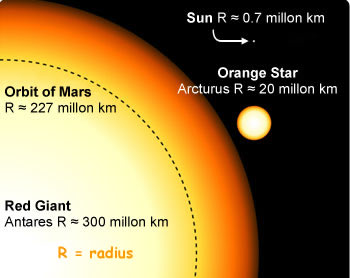The Death of Small and Medium-sized Stars
 In about 4 to 5 billion years from now the Sun will will begin to exhaust its supply of hydrogen fuel. In about 4 to 5 billion years from now the Sun will will begin to exhaust its supply of hydrogen fuel.
The Sun's core will then collapse under its own gravity as the outward pressure of the core decreases (because fusion reactions deep within the core are less prevelant).
This will make the core hotter.
Its atmosphere (the outer atom nuclei) will become unstable because of the increased pressure from the hotter core and start to expand.
This will transform the Sun into a huge red giant star.
At the bloated surface, the increased amount of energy will be spread out over a larger area so each square metre will be cooler.
The surface will have a red colour because it is so much cooler than it was at the yellow stable stage and will be much further from the center than during the main sequence.
Our Sun will swell in size to encompass the inner planets (perhaps Earth too) when this happens!
Despite its cooler surface temperature, a red giant is very luminous because of its enormous surface area; so even if the Earth is not swallowed up when our Sun becomes a red giant, conditions on the planet will become impossible for life to exist. The surface temperature would be so high that the oceans and atmosphere would have evaporated away.
Finally, when the fuel runs out completely the crushing force of gravity makes the star collapse under the force of its own weight; as it is a relatively small star, it will collapse gently and remains collapsed. Such a collapsed star, at its life's end, is called a white dwarf. Our Sun will probably end its life in this way.
It will continue to shine as radiation will still given out from electron promotion/demotion transitions until the kinetic energy of the atoms diminishes enough to stop radiation emission - it will then be a black dwarf - a cold mass moving through space.
|


